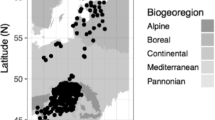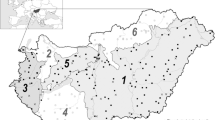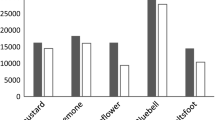Abstract
The onset of flowering in 78 wild and domesticated terrestrial plant species recorded in South Moravia (Czech Republic) from 1965 to 2014 was correlated with the North Atlantic Oscillation (NAO) index of the preceding winter. Flowering occurred significantly earlier following positive winter NAO phases (causing spring to be warmer than normal in Central Europe) in nearly all early-flowering (March, April) species; high Pearson correlation values were recorded in, e.g., goat willow, spring snowflake, golden bell, cornelian cherry, sweet violet, cherry plum, grape hyacinth, apricot, blackthorn, common dandelion, cherry, southern magnolia, common apple, cuckoo flower, European bird cherry, and cherry laurel. In contrast, the timing of later-flowering plant species (May to July) did not correlate significantly with the winter NAO index. It was found that local temperature is obviously a proximate factor of plant phenology, while the winter NAO is the ultimate factor, affecting temperature and other meteorological phenomena in Central Europe during spring season.
Similar content being viewed by others
Avoid common mistakes on your manuscript.
Introduction
The North Atlantic Oscillation system (NAO) of atmospheric circulation is a major determinant of weather and climate fluctuation in Europe and eastern North America (Wallace and Gutzler 1981; Barnston and Livezey 1987; Hurrell 1995). The winter NAO index is a simple approximate descriptor of weather over most of Europe in the following spring and summer. It also affects phenological phases of different biota. While a number of papers have reported the relationship between the NAO and animal (bird, fish, etc.) phenology, the effect of the NAO on the timing of flowering in plants has been studied relatively less often, and the studies generally involved only a limited number of plant species in a few European countries (Post and Stenseth 1999; Scheifinger et al. 2002; Menzel 2003; Aasa et al. 2004; Cook et al. 2005; Gormsen et al. 2005; Ahas and Aasa 2006; Menzel et al. 2008; Nordli et al. 2008; Kalvane et al. 2009), with some exceptions (Menzel et al. 2005).
However, the effect of the NAO on biota might differ regionally within Europe. The aim of the present study was to evaluate whether the NAO also affected the flowering of plants in Central Europe. In this study, a longitudinal record (spanning up to 50 years) on the onset of flowering in a large number of plant species growing in southern Moravia (Czech Republic) was correlated with the winter NAO index. In addition, the effect of local meteorological variables (temperature, precipitation, snow cover, relative humidity of the air) on the flowering was also evaluated.
Materials and methods
Study area
Observations were made in the district of Breclav (48° 40′–49° 05′ N, 16° 30′–17° 00′ E; ∼150–200 m above sea level), southern Moravia (Czech Republic).
Phenological records
Long-term records of phenological events of particular plant species were made by the author during the period 1965–2014. Excluding plant species with less than 15 annual records resulted in 78 wild and domesticated terrestrial plant species retained for analysis. Plants were checked for flowering every 3–4 days from March to July. The beginning of flowering was defined as the calendar date when approximately 20 % of flowers of a particular plant population or a tree/shrub were already open. In one species (silver birch), leafing (∼20 % leaf unfolding) was used as the phenological event.
North Atlantic Oscillation data
Winter (December–March) NAO indices for the study years were obtained from https://climatedataguide.ucar.edu/sites/default/files/climate_index_files/nao_station_djfm_0.txt (Hurrell 1995). This index is station-based on normalized sea level pressure differences between Ponta Delgada (Azores) and Stykkisholmur (Iceland). A positive NAO index means that the atmospheric pressure over the subtropical part of the North Atlantic is higher than normal while that over the northern sector of the North Atlantic is lower than normal; this increased pressure difference between the two sectors results in more and stronger storms crossing the Atlantic Ocean and, in turn, also causes warm and wet weather in northern and central Europe (Hurrell 1995). A negative NAO index reflects the opposite pattern of height and pressure anomalies over these sectors; this reduced pressure gradient results in fewer and weaker storms crossing the Atlantic Ocean and brings cold air to northern and central Europe and moist and often cold air into the Mediterranean.
Local meteorological data
Daily meteorological data, obtained from the meteorological station Lednice (situated in the study area 48.79 N, 16.80 E; 173 m a.s.l.) for the years 1965–2014, were supplied by the Czech Hydrometeorological Institute in Brno: average (TAVG), maximum (TMAX), and minimum (TMIN) temperature of the air, precipitation (mm, PREC), snow cover (cm, SNOW) at 07 h, and relative humidity of the air (%, RH). Monthly and annual averages (TAVG, TMAX, TMIN, SNOW, RH) or sums (PREC) were calculated and compared with seasonal NAO data and phenological events in individual plant species.
Statistical analysis
Calendar dates of phenological events were transformed into Julian days. Pearson correlations were used to examine the linear relationships between the winter NAO index or meteorological data and phenological events of each plant species. The data did not deviate significantly from a normal distribution, and there was no significant autocorrelation at lag 1 within the winter NAO index (results not shown).
Results
A significant (P < 0.05) correlation between flowering and winter NAO index was found in 36 of the 78 species tested (Table 1). All these species were negatively correlated with the winter NAO index, i.e., flowering started earlier following the higher NAO index values. Nearly all early spring flowering plant species had significant correlations with the winter NAO index (Table 2), and markedly high r values, |r| > 0.5, were recorded in goat willow, spring snowflake, golden bell, cornelian cherry, sweet violet, cherry plum, grape hyacinth, apricot, blackthorn, common dandelion, cherry, southern magnolia, common apple, cuckoo flower, European bird cherry, and cherry laurel. This indicates that more than 25 % of the variability in the start of flowering of these plant species is attributable to the NAO index. In contrast, all of the later-flowering plant species (those flowering in May, June, and July), except for horse chestnut, which is however the earliest of later-flowering species, did not correlate significantly with the winter NAO index.
For the study area, a significant long-term correlation was found between the winter NAO index and local air temperature (r = +0.500), precipitation (r = −0.341), snow cover (r = −0.691), and relative humidity of the air (r = −0.443) in the period from 1965 to 2014 (50 years, Table 3). The results for TMAX and TMIN were similar to those for TAVG and are not given in Table 3.
Table 4 shows Pearson correlation between flowering events in plants and the winter NAO or monthly meteorological data (TAVG, PREC, SNOW, RH) recorded in the study area from 1965 to 2014. In all plant species with significant correlation of flowering event with the winter NAO, a significant correlation was also detected with the air temperature in January, February, or March—the only exception being cherry laurel. Sometimes, the correlation with temperature was higher than that with the winter NAO, e.g., in two-leaf squill, lesser celandine, yellow star-of-Bethlehem, cherry plum, corydalis, cowslip primrose, apricot, garlic mustard, and common sedge. Moreover, flowering in a number of species correlated significantly with temperature, but not with the winter NAO index, e.g., yellow marsh marigold, spring pea, common pear, cypress spurge, celandine, common bugle, woodland strawberry, whitetop, ramsons, crambe, tamarisk, common comfrey, Midland hawthorn, bladder campion, and purple murein. It is therefore reasonable to consider local air temperature as a more important factor in the flowering events than the remote NAO. A significant correlation of phenological events with monthly precipitation was much less frequent (Table 4). On the other hand, snow cover obviously plays an important role in delaying start of flowering, due to a combined effect of temperature and precipitation (Table 4). Also, relative humidity of the air seems to affect flowering events in many species, especially in March: The higher the humidity, the later the flowering observed in sweet violet, cherry plum, corydalis, yellow anemone, apricot, cowslip primrose, Norway maple, blackthorn, common dandelion, cherry, southern magnolia, common pear, common apple, cuckoo flower, white deadnettle, wayfaring tree, showy buttercup, common comfrey, ragged robin, black locust tree, etc. (Table 4).
Discussion
Air temperature is a very important factor in determining the beginning of the growing season and in the phenology of plant flowering, and average air temperature in Europe (except for southern Europe) is correlated with the NAO index (Sparks et al. 2000; Chmielewski and Rötzer 2001; D’Odorico et al. 2002; Aasa et al. 2004; Ahas and Aasa 2006). This was confirmed in this study as well: Local temperature is obviously a proximate factor in plant phenology, while the winter NAO is the ultimate factor, affecting temperature and other meteorological phenomena in Central Europe mainly during the spring season.
The current study showed that plant species flowering in early spring started earlier after positive winter phases of the NAO while later-flowering (midseason) plant species were less affected following such warm winters; this is in accord with similar phenological studies in other European countries (Post and Stenseth 1999; Aasa et al. 2004; Ahas and Aasa 2006). For example, Aasa et al. (2004), as part of a wider study, reported significant correlations between the winter NAO index and phenological events in three plant species in Weiz, Austria (47.22 N, 15.63 E; i.e., close to my study area) during 1951–1998. Their correlations (current study data in parentheses) were −0.57 (−0.33) for coltsfoot, −0.46 (−0.42) for common lilac, and −0.37 (−0.47) for silver birch leaf unfolding. Some studies have shown that the effect of the NAO on plant phenology is more marked in the Baltic states than in Central Europe, with generally larger coefficients of correlation between the winter NAO index and the onset of spring phenological phases (up to −0.60; Aasa et al. 2004; Gormsen et al. 2005; Kalvane et al. 2009).
One important question is whether the winter NAO index could be used to forecast the onset of flowering. The answer is yes for certain early-flowering plants, including economically important domesticated trees such as apricot, cherry, peach, and apple. In these species, forecasts could be developed by calculating linear regressions of the beginning of flowering (in Julian days) on the preceding winter NAO index. For the study area and the current dataset, the simple regression models are 98.0 − 2.6335 NAO (apricot), 106.0 − 2.1335 NAO (cherry), 107.4 − 1.7182 NAO (peach), and 112.7 − 1.9575 NAO (apple), where NAO means the value of the preceding winter NAO index (December to March).
References
Aasa A, Jaagus J, Ahas R, Sepp M (2004) The influence of atmospheric circulation on plant phenological phases in central and eastern Europe. Int J Climatol 24:1551–1564
Ahas R, Aasa A (2006) The effects of climate change on the phenology of selected Estonian plant, bird and fish populations. Int J Biometeorol 51:17–26
Barnston AG, Livezey RE (1987) Classification, seasonality and persistence of low-frequency atmospheric circulation patterns. Mon Weath Rev 115:1083–1126
Chmielewski FM, Rötzer T (2001) Response of tree phenology to climate change across Europe. Agric Forest Meteorol 108:101–112
Cook BI, Smith TM, Mann ME (2005) The North Atlantic Oscillation and regional phenology prediction over Europe. Global Change Biol 11:919–926
D’Odorico P, Yoo J, Jaeger S (2002) Changing seasons: an effect of the North Atlantic Oscillation? J Clim 15:435–445
Gormsen AK, Hense A, Toldam-Andersen TB, Braun P (2005) Large-scale climate variability and its effects on mean temperature and flowering time of Prunus and Betula in Denmark. Theor Appl Climatol 82:41–50
Hurrell JW (1995) Decadal trends in the North Atlantic Oscillation: regional temperatures and precipitation. Science 269:676–679
Kalvane G, Romanovskaja D, Briede A, Baksiene E (2009) Influence of climate change on phenological phases in Latvia and Lithuania. Clim Res 39:209–219
Menzel A (2003) Plant phenological anomalies in Germany and their relation to air temperature and NAO. Clim Change 57:243–263
Menzel A, Sparks TH, Estrella N, Eckardt S (2005) "SSW to NNE"—North Atlantic Oscillation affects the progress of seasons across Europe. Global Change Biol 11:909–918
Menzel A, Estrella N, Schleip C (2008) Impacts of climate variability, trends and NAO on 20th century European plant phenology. In: Brönnimann S, Luterbacher J, Ewen T, Diaz HF, Stolarski R, Neu U (eds) Climate variability and extremes during the past 100 years, vol 33, Advances in global change research. Springer, Berlin, pp 221–233
Nordli O, Wielgolaski FE, Bakken AK, Hjeltnes SH, Mage F, Sivle A, Skre O (2008) Regional trends for bud burst and flowering of woody plants in Norway as related to climate change. Int J Biometeorol 52:625–639
Post E, Stenseth NC (1999) Climatic variability, plant phenology, and northern ungulates. Ecology 80:1322–1339
Scheifinger H, Menzel A, Koch E, Peter C, Ahas R (2002) Atmospheric mechanisms governing the spatial and temporat variability of phenological phases in central Europe. Int J Climatol 22:1739–1755
Sparks TH, Jeffree EP, Jeffree CE (2000) An examination of relationships between flowering times and temperature at the national scale using long-term phenological record from the UK. Int J Biometeorol 44:82–87
Wallace JM, Gutzler DS (1981) Teleconnections in the geopotential height field during the Northern Hemisphere winter. Mon Weath Rev 109:784–812
Author information
Authors and Affiliations
Corresponding author
Rights and permissions
About this article
Cite this article
Hubálek, Z. The North Atlantic Oscillation system and plant phenology. Int J Biometeorol 60, 749–756 (2016). https://doi.org/10.1007/s00484-015-1070-2
Received:
Revised:
Accepted:
Published:
Issue Date:
DOI: https://doi.org/10.1007/s00484-015-1070-2




